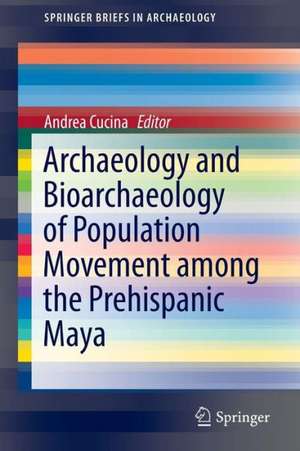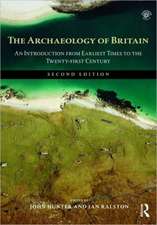Archaeology and Bioarchaeology of Population Movement among the Prehispanic Maya: SpringerBriefs in Archaeology
Editat de Andrea Cucinaen Limba Engleză Paperback – 3 dec 2014
The contributions of this volume bring together contributions from archaeology, archaeometry, paleodemography and bioarchaeology. They provide an initial account of the dynamic qualities behind large–scale ancient population dynamics, and at the same time represent novel multidisciplinary points of departure towards an integrated reconstruction and understanding of Prehispanic population dynamics in the Maya region.
Din seria SpringerBriefs in Archaeology
-
 Preț: 447.84 lei
Preț: 447.84 lei -
 Preț: 382.95 lei
Preț: 382.95 lei -
 Preț: 381.00 lei
Preț: 381.00 lei -
 Preț: 386.22 lei
Preț: 386.22 lei -
 Preț: 379.68 lei
Preț: 379.68 lei -
 Preț: 381.00 lei
Preț: 381.00 lei -
 Preț: 378.71 lei
Preț: 378.71 lei -
 Preț: 381.81 lei
Preț: 381.81 lei - 15%
 Preț: 470.24 lei
Preț: 470.24 lei -
 Preț: 411.32 lei
Preț: 411.32 lei -
 Preț: 382.95 lei
Preț: 382.95 lei -
 Preț: 448.38 lei
Preț: 448.38 lei -
 Preț: 377.35 lei
Preț: 377.35 lei -
 Preț: 448.28 lei
Preț: 448.28 lei -
 Preț: 380.84 lei
Preț: 380.84 lei -
 Preț: 377.18 lei
Preț: 377.18 lei -
 Preț: 379.86 lei
Preț: 379.86 lei -
 Preț: 445.33 lei
Preț: 445.33 lei -
 Preț: 413.45 lei
Preț: 413.45 lei -
 Preț: 406.79 lei
Preț: 406.79 lei -
 Preț: 412.13 lei
Preț: 412.13 lei -
 Preț: 420.68 lei
Preț: 420.68 lei -
 Preț: 457.35 lei
Preț: 457.35 lei - 20%
 Preț: 386.76 lei
Preț: 386.76 lei -
 Preț: 316.95 lei
Preț: 316.95 lei -
 Preț: 281.65 lei
Preț: 281.65 lei -
 Preț: 349.47 lei
Preț: 349.47 lei -
 Preț: 377.18 lei
Preț: 377.18 lei -
 Preț: 381.98 lei
Preț: 381.98 lei -
 Preț: 487.37 lei
Preț: 487.37 lei -
 Preț: 381.00 lei
Preț: 381.00 lei -
 Preț: 381.00 lei
Preț: 381.00 lei
Preț: 381.21 lei
Nou
Puncte Express: 572
Preț estimativ în valută:
72.94€ • 76.17$ • 60.23£
72.94€ • 76.17$ • 60.23£
Carte tipărită la comandă
Livrare economică 15-29 aprilie
Preluare comenzi: 021 569.72.76
Specificații
ISBN-13: 9783319108575
ISBN-10: 3319108573
Pagini: 150
Ilustrații: XIII, 159 p. 43 illus., 16 illus. in color.
Dimensiuni: 155 x 235 x 10 mm
Greutate: 0.25 kg
Ediția:2015
Editura: Springer International Publishing
Colecția Springer
Seria SpringerBriefs in Archaeology
Locul publicării:Cham, Switzerland
ISBN-10: 3319108573
Pagini: 150
Ilustrații: XIII, 159 p. 43 illus., 16 illus. in color.
Dimensiuni: 155 x 235 x 10 mm
Greutate: 0.25 kg
Ediția:2015
Editura: Springer International Publishing
Colecția Springer
Seria SpringerBriefs in Archaeology
Locul publicării:Cham, Switzerland
Public țintă
ResearchCuprins
Introduction. Andrea Cucina.- Chapter 1: Xcambo and its Commercial Dynamics Within the Framework of the Maya Area. Thelma N. Sierra Sosa.- Chapter 2: Ceramic Traditions in the Calakmul Region: An Indicator of the Movement of Ideas or Populations? María del Rosario Domínguez Carrasco & William J. Folan.- Chapter 3: Cultural Interchange Regarding the Distribution of Fine Paste Ceramics Within Riverine Societies Along the Usumacinta’s Mid to Low Basin and Various Gulf Coast’s Communities. Socorro del Pilar Jiménez Alvarez.- Chapter 4: Calakmul: Power, Perseverance and Persistence. William J. Folan, Maria del Rosario Domínguez Carrasco, Joel D. Gunn, Abel Morales L., Raymundo González H., Gerardo Villanueva García & Nuría Torrescano Valle.- Chapter 5: The Historic Presence of Itza, Putun and Toltec in the Maya Lowlands at the End of the Classic and Postclassic Periods. Rafael Cobos.- Chapter 6: The Use of Theoretical and Methodological Bases in Population Movements’ Studies: Paleo and Archaeo Demographic Approaches. Allan Ortega Muñoz.- Chapter 7: Population Dynamics during the Classic and Postclassic Period Maya in the Northern Maya Lowlands: The Analysis of Dental Morphological Traits. Andrea Cucina.- Chapter 8:The Buk Phase Burials of Belize: Testing Genetic Relatedness Among Early Postclassic Groups in Northern Belize Using Dental Morphology. Gabriel Wrobel & Elizabeth Graham.- Chapter 9: Dental Nonmetric Investigation of Population Dynamics at Mayapan. Stanley Serafin, Carlos Peraza Lope & Andrea Cucina.- Chapter 10: Dental Morphometric and Strontium Isotope Evidence for Population History at Tikal, Guatemala. Andrew K. Scherer & Lori E. Wright.- Chapter 11: Strontium Isotopes and the Study of Human Mobility Among the Ancient Maya. T. Douglas Price, James H. Burton, Paul D. Fullagar, Lori E. Wright, Jane E. Buikstra & Vera Tiesler.-Chapter 12: House Or Lineage? How Intracemetery Kinship Analysis. Contributes To The Debate In The Maya Area. William N. Duncan & Jon B. Hageman.- Chapter 13: Shifts in Artificial Head Forms, Population Movements, and Ethnicity Among the Postclassic Maya. Vera Tiesler.
Notă biografică
Andrea Cucina
Doctorate degree in Paleopathology (1998), Catholic University of Rome, School of Medicine, Italy. Laurea (honoris) in Biological Sciences with a major in Physical anthropology, University of Rome La Sapienza. Currently, Full Professor at the School of Anthropological Sciences, Autonomous University of Yucatán in Merida, (Mexico). Member of the National System of Investigators Level II (Mexico). He has carried out field and lab research in Italy, Dominican Republic República, Pakistan, Florida, México and Guatemala. His main interest is in dental anthropology of extant and recent populations. Currently, it focuses on paleodiet, paleopathology, developmental stress and population dynamics of the ancient Mayas (though not exclusively), and the early colonizers on the New World, as well as on biodistance studies of pre- and proto-historic populations in Europe and South America. He is Book Review Editor of HOMO, Journal of Comparative Human Biology, and member of several academic international associations. He has authored or co-authored more than eighty scientific papers in international journals (American Journal of Physical Anthropology, Journal of Archaeological Sciences, Latin American Antiquity, NATURE, International Journal of Osteoarchaeology, HOMO and more), chapter in edited volumes, and has edited six books.
Doctorate degree in Paleopathology (1998), Catholic University of Rome, School of Medicine, Italy. Laurea (honoris) in Biological Sciences with a major in Physical anthropology, University of Rome La Sapienza. Currently, Full Professor at the School of Anthropological Sciences, Autonomous University of Yucatán in Merida, (Mexico). Member of the National System of Investigators Level II (Mexico). He has carried out field and lab research in Italy, Dominican Republic República, Pakistan, Florida, México and Guatemala. His main interest is in dental anthropology of extant and recent populations. Currently, it focuses on paleodiet, paleopathology, developmental stress and population dynamics of the ancient Mayas (though not exclusively), and the early colonizers on the New World, as well as on biodistance studies of pre- and proto-historic populations in Europe and South America. He is Book Review Editor of HOMO, Journal of Comparative Human Biology, and member of several academic international associations. He has authored or co-authored more than eighty scientific papers in international journals (American Journal of Physical Anthropology, Journal of Archaeological Sciences, Latin American Antiquity, NATURE, International Journal of Osteoarchaeology, HOMO and more), chapter in edited volumes, and has edited six books.
Caracteristici
Only book to assess Maya population dynamics from a multidisciplinary perspective Highlights archaeological evidence that connects the Maya and Teotihuacan in the Mexican Central Highlands Focuses on archaeology and bioarchaeology to explain specific dynamics of the Maya Includes supplementary material: sn.pub/extras














